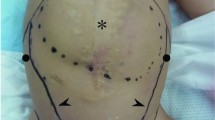Abstract
Abdominal wall reconstruction in omphalopagus twins poses a difficult reconstructive challenge, as separation often results in a large abdominal wall defect. A number of options are available for closure, including tissue flaps, expanders and patches made of foreign material. Surgisis® is a new biodegradable small intestine scaffolding substrate that permits tissue in-growth and results in a permanent durable scar. We describe its use in abdominal wall reconstruction after separation of a set of conjoined twins. A set of omphalopagus conjoined twins shared liver and abdominal wall. After separation at 6 months of age, Twin A’s abdomen could be closed primarily, but Twin B could not. A 4-ply Surgisis® mesh was used in the upper abdominal closure, and a skin flap was created, to completely cover the patch. Both twins survived the operation. A small portion of the skin flap over the Surgisis® broke down, healing by secondary intention. In follow up of over 18 months post procedure, there have been no wound infections and the abdominal wall is intact with no evidence of a hernia. Surgisis® can be successfully used for the reconstruction of complex abdominal wall defects in the pediatric patient, including reconstruction after separation of conjoined twins.


Similar content being viewed by others
References
O’Neill JA Jr, Holcomb GW 3rd, Schnaufer L et al (1988) Surgical experience with thirteen conjoined twins. Ann Surg 208:299–312
Spencer R (1996) Anatomic description of conjoined twins: a plea for standardized terminology. J Pediatr Surg 31:941–944
Hilfiker ML, Hart M, Holmes R et al (1988) Expansion and division of conjoined twins. J Pediatr Surg 33:768–770
Zuker RM, Filler RM, Lalla R (1986) Intra-abdominal tissue expansion: an adjunct in the separation of conjoined twins. J Pediatr Surg 21:198–200
Canty TG Sr, Mainwaring R, Vecchione T et al (1998) Separation of omphalopagus twins: unique reconstruction using syngeneic cryopreserved tissue. J Pediatr Surg 33:750–753
Yokomori K, Ohkura M, Kitano Y, Nakajo et al (1993) Comprehensive planning of operative strategy for separation of ischiopagus tripus twins with particular reference to quality of life. J Pediatr Surg 28:833–837
Doski JJ, Heiman HS, Solenberger RI et al (1997) Successful separation of ischiopagus tripus conjoined twins with comparative analysis of methods for abdominal wall closure and use of the tripus limb. J Pediatr Surg 32:1761–1766
Badylak SF, Lantz GC, Coffey A, Geddes LA (1989) Small intestinal submucosa as a large diameter vascular graft in the dog. J Surg Res 47:74–80
Lantz GC, Badylak SF, Coffey AC et al (1990) Small intestinal submucosa as a small-diameter arterial graft in the dog. J Invest Surg 3:217–227
Grethel EJ, Cortes RA, Wagner AJ et al (2006) Prosthetic patches for congenital diaphragmatic hernia repair: Surgisis vs Gore-Tex. J Pediatr Surg 41:29–33
Admire AA, Greenfeld JI, Cosentino CM, Ghory MJ, Samimi KJ (2003) Repair of cloacal exstrophy, omphalocele, and gastroschisis using porcine small-intestinal submucosa or cadaveric skin homograft. Plast Reconstr Surg 112:1059–1062
Strange PS (2003) Small intestinal submucosa for laparoscopic repair of large paraesophageal hiatal hernias: a preliminary report. Surg Technol Int 11:141–143
Helton WS, Fisichella PM, Berger R, Horgan S, Espat NJ, Abcarian H (2005) Short-term outcomes with small intestinal submucosa for ventral abdominal hernia. Arch Surg 140:549–60
Holcomb GW 3rd, Ostlie DJ, Miller KA (2005) Laparoscopic patch repair of diaphragmatic hernias with Surgisis. J Pediatr Surg 40:E1–5
Badylak S, Kokini K, Tullius B, Whitson B (2001) Strength over time of a resorbable bioscaffold for body wall repair in a dog model. J Surg Res 99:282–287
Dejardin LM, Arnoczky SP, Clarke RB (1999) Use of small intestinal submucosal implants for regeneration of large fascial defects: an experimental study in dogs. J Biomed Mater Res 46:203–211
Sandoval JA, Lou D, Engum SA et al (2006) The whole truth: comparative analysis of diaphragmatic hernia repair using 4-ply vs 8-ply small intestinal submucosa in a growing animal model. J Pediatr Surg 41:518–523
Franklin ME Jr., Gonzalez JJ Jr., Michaelson RP et al (2002) Preliminary experience with new bioactive prosthetic material for repair of hernias in infected fields. Hernia 6:171–174
Ueno T, Pickett LC, de la Fuente SG et al (2004) Clinical application of porcine small intestinal submucosa in the management of infected or potentially contaminated abdominal defects. J Gastrointest Surg 8:09–112
Hodde JP, Record RD, Liang HA et al (2001) Vascular endothelial growth factor in porcine-derived extracellular matrix. Endothelium 8:11–24
Gabriel A, Gollin (2006) Management of complicated gastroschisis with porcine small intestinal submucosa and negative pressure wound therapy. J Pedtr Surg 11:1836–1840
Author information
Authors and Affiliations
Corresponding author
Rights and permissions
About this article
Cite this article
Dasgupta, R., Wales, P.W., Zuker, R.M. et al. The use of Surgisis® for abdominal wall reconstruction in the separation of omphalopagus conjoined twins. Pediatr Surg Int 23, 923–926 (2007). https://doi.org/10.1007/s00383-007-1909-7
Accepted:
Published:
Issue Date:
DOI: https://doi.org/10.1007/s00383-007-1909-7




